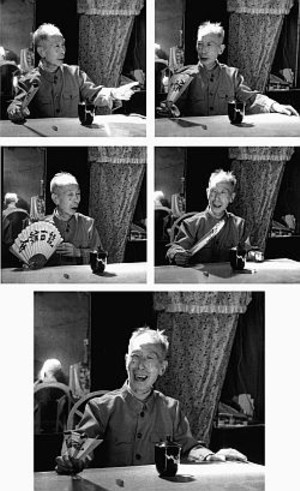Elements of Performance (12)

Humour and digression
The narrative is divided into the "real story" zheng shu and extraneous digressions of various kinds. The real story is about people and happenings that traditionally are told in this connection. Sometimes the storyteller may interpolate extraneous stuff, called "stories outside the story" shu wai shu or "trifles" xiezi. One reason for adding digressions is simply to fill the time schedule. For example: if one storyteller is soon to finish his "job" in the storytellers' house, but the person engaged for the next period has not arrived, then the owner may want the first to stay a little longer. Therefore the storyteller thinks out how to make amendments and extra digressions in order to continue his story for some more days, called to "drag on" tuo.
Another reason is that digressions, whether extraneous or belonging to the "real story" are most often of a humorous character, "jests" ke and "witticisms" xuezi. The performer will "insert a jest" cha ke that has nothing to do with the plot, in order to arouse people's interest. Sometimes he will manage to make a "jest for the whole theatre" mantang ke and provoke a hearty laughter from everybody, after which he must "give room for the jest" rang ke, i.e. make a short pause so that people can recover from laughing, before he continues his story. While some professional oral arts in China, such as "comic dialogues" xiangsheng, are laughter-provoking to an extreme degree, seeking to make the audience laugh almost continuously throughout the performance, storytelling appeals to a more subtle humour. The audience of storytelling will only infrequently break out in a loud laughter. Rather the listeners will chuckle from amusement every now and then, while being quite earnest in between. This humour is based on a common tacit understanding between the artist and the audience. The enjoyment of the humour is shown by a silent smile, a nodding of mutual understanding. Some schools of storytelling are, however, particularly famous for a kind of slap-stick humour, e.g. the Journey to the West and the Qingfeng Sluice .
The humour and jokes of storytelling are traditionally divided into the dirty and the clean, called "fishy" hunde and "vegetarian" sude. Storytelling in recent years seems to be extremely "vegetarian" after fifty years of purism during the People's Republic. We still have the categories, though, a reminder that storytelling, like many other oral genres of entertainment, used to be quite juicy.
The storyteller may end the performance of the day by "dropping a jest" diu ke and make the audience laugh, but more often he will "bargain a crisis" mai guanzi, giving an exciting hint to what is going to happen in the next episode, an old trick to make the audience return the following day.
Video: (Gao Zaihua)
(.mpeg 1.6Mb)
(.wmv 0.5Mb)